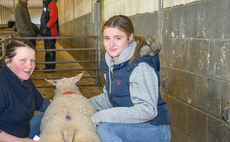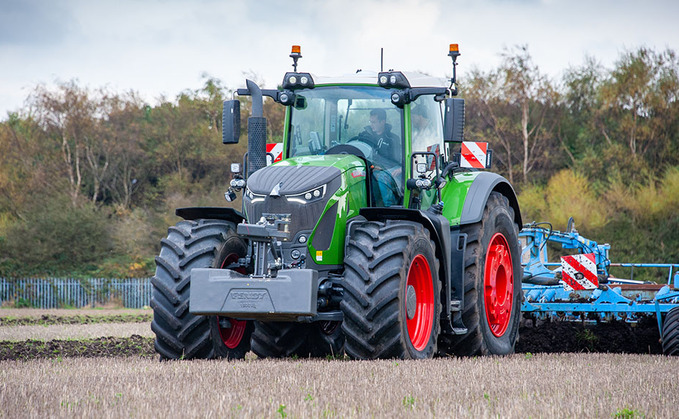
As one of its most popular models in the UK, there is a lot riding on Fendt's new 900 Vario tractor series. But with so much change, will it still appeal? James Rickard finds out with a test drive.
Adopting much of the technology and hardware designed for the larger 1000 Vario series, Fendt has completely overhauled is venerable 900 Vario tractor series and given it a thorough update.
Among the raft of major updates to the sixth generation machine are a new engine, transmission, hydraulics package and cab. Also, not forgetting the striking new look.
To find out more, we got our hands on the 415hp flagship 942 model. As before, five models make up the series. However, with the addition of the new, more powerful flagship 942, the firm has dropped the smallest model, the 927.
In addition, the manufacturer has made a concerted effort to make this tractor appeal to more of a global audience. In particular for America, it can now meet the crucial 1.5m (60 inch) track width for row-crop tyres, hence why there are no air tanks on the inside of the rear rims.
Though the new 900 series is just over a tonne heavier than its predecessor, dimensions-wise it is not that much bigger. Wheelbase is 100mm longer, but overall length is the same; width on the same tyres is similar; and overall height is only fractionally taller.
Engine
eng 1
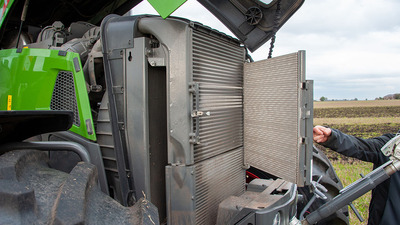
Up-front, the previously-used Deutz motor has been dropped in favour of a MAN unit. With this newly-developed engine, in partnership with Fendt, comes with it the low revving, high torque characteristics required by the new VarioDrive transmission.
Maximum rated engine speed is a truck-inspired 1,700rpm, with an idle speed of 650rpm. However, it is the torque which will impress, which is up to 24 per cent more over the old flagship. Topping out at 1,970Nm on the 942, the bulk of this is available between 1,150rpm to 1,350rpm, making it fit for heavy draft work. It also produces quite a satisfying rumble.
Employing a structural sump, it means there are no chassis rails to get in the way of those front wheels when turning. Its ‘wasp waist' design, with the cooling package sat over the front axle, also enables a steering angle of 41 degrees.
eng 2
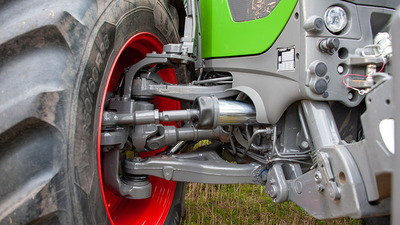
Specifically designed and built as a Stage 5-compliant engine from the off, it means the engine has not been subject to constant updates and additions to meet the ever evolving emissions regulations, says the manufacturer.
However, it does use plenty of tricks to keep emissions down including selective catalytic reduction using AdBlue, a diesel particulate filter (DPF) and a diesel oxidation catalyst. Critically though it does without the need for exhaust gas recirculation, with all emissions dealt with after the combustion process. This means the engine can stick to doing what it does best, producing power and torque.
As a result, it can burn hotter and cleaner, which means it needs fewer DPF re-gens, but this in turn creates more nitrous oxide, which needs more AdBlue to deal with it.
eng 3

Compared to the rate of fuel use, AdBlue consumption is up from about 4 per cent to 8 per cent. But, according to feedback, average fuel use of the new 900s is about 12 litres/hour less on the same job.
Cooling package layout is pretty similar to the old model. There are not many swing out elements to it, so you do need to reach in there should debris build up. However, because the firm opted not to use the push type cooling system as used on its 1000 and 900MT series tractors, it means you can still specify a front PTO.
Transmission
trans 1
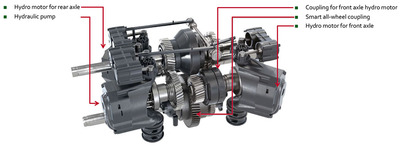
First used in the manufacturer's 1000 series wheeled tractor then in the 900MT series twin tracked machines, the VarioDrive continuously variable transmission (CVT) has now made its way into the new 900 series. For all intents and purposes it is exactly the same transmission, which along with the new engine and heavier-duty front axle, is responsible for adding about one tonne to the tractor. The main difference for the 900 is a lighter-duty final drive.
Similar to the previous CVT in the 900, this new version also features one hydrostatic pump and two hydro-motors. But unlike before, where the two motors would drive the back axle with the front axle driven mechanically, VarioDrive splits the hydrostatic power with one motor powering the front axle and one powering the rear. This is said to give greater control over traction, with the tractor automatically shuffling power between front and rear axle, depending on which one has the most traction.
trans 2
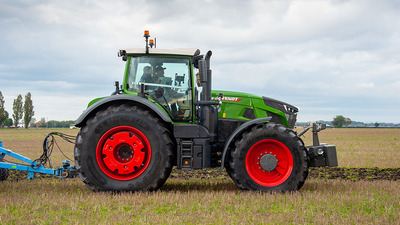
In some of the stickier parts of the field during our cultivating stint, this power shuffle was really noticeable, allowing the tractor to make the most of its available power and maintain grip. At no point are the front and rear axles mechanically locked.
This ‘fluid' 4WD has further benefits which include no transmission wind-up, and the ability to provide a pull-in effect when turning. The latter works automatically and sees the front axle speed up slightly when turning, ‘pulling' the front-end of the tractor round. This comes into its own on headland turns, which allows the new 900 to pretty much maintain the same turning circle as the previous 900 which had a shorter wheelbase.
trans 3
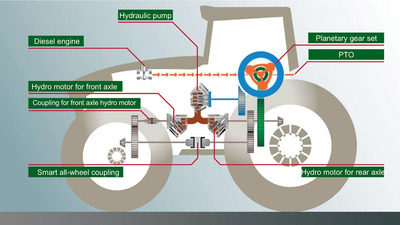
In terms of power delivery to the axles:
- From a standing start, where maximum traction is required, both hydro-motors will be fully engaged. Even on the road, this is said to be more efficient at low speeds, as the front axle does not have to be pushed and helps ‘launch' the tractor.
- As the tractor approaches 25kph, the front axle motor will gradually begin to back off, as its requirement gets less.
- Above 25kph, the front axle motor will move to its neutral position, with drive between front and rear axles now completely uncoupled. This reduces drag losses.
- At top speed, the rear axle is fully mechanically driven.
It is practically imperceivable that any of the above is happening while driving, unlike the tracked version, where you could almost hear every movement of the hydro pumps and motors.
Cab and controls
cab 1

While the interior of the cab will look familiar to Fendt operators, the frame is brand new, taken from the 1000 series. Immediately, you will notice the easier access provided for by the wider doorway and steps.
Internal space is plentiful too, with several bottle and cup holders positioned throughout the cab, along with various cubby holes and net holders.
External storage is now boosted by a useful compartment on the right hand side of the tractor. This features a slide out tray onto which a proper metal cantilever toolbox can be specified. Behind this there is also plenty of room for PTO stub shafts and the like.
tool b
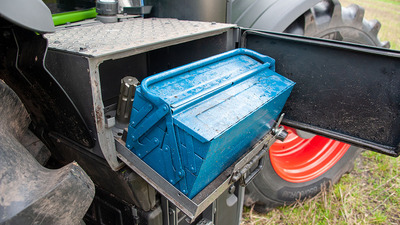
The biggest difference operators will notice on the right-hand console are the absence of the range change and 4WD buttons, due to the new VarioDrive transmission. These have been replaced by the new infotainment control buttons.
Also absent is a radio head unit, with all infotainment controlled and set up through the touch screen terminal, including the ability to pair/sync own devices to access contacts and music.
buttons
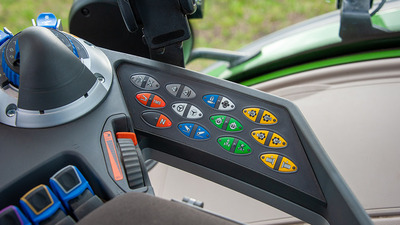
On top the infotainment system is a new 4.1 surround sound system, which will probably be the first thig that catches your attention, way before you notice the bits that the firm has spent millions developing. Also, to make phone calls clearer, particularly for the person you are calling, eight mics are placed throughout the tractor's roof lining, designed to avoid any drop outs as you turn your head.
In terms of tractor operation and control layout, this is the same as before. Which compared to the rest of the tractor, is now starting to look a bit dated. However, you may have seen in the press a new control concept on the horizon, which will first be rolled out on the volume-selling 700 series - but it could be anywhere between two and four years before the 900s get it.
console
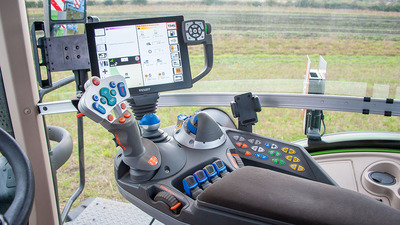
Other additions include an auto-park brake, electrically-controlled telescoping wing mirrors, in-cab air supply and individual cut key. The latter is unique to one tractor, and cannot be used to open or start another.
Finally, despite the extra girth around the front end, visibility over and around the re-sculpted bonnet is surprisingly good. Usefully, a camera in the nose, helps when hooking up to front-mounted implements.
Hydraulics
rear
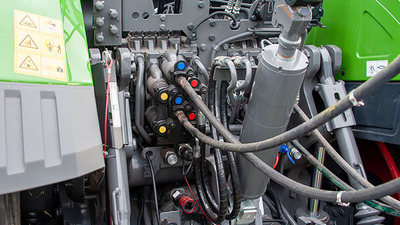
Like the rest of the tractor, its hydraulics have also been up-rated. As standard it is equipped with a 165l/min load-sensing pump, or you can opt for a larger 220l/min unit. As well as the larger pump, you can also specify a second 210l/min pump.
Perhaps a little excessive for most UK users, two high capacity pumps would allow the use of two separate hydraulic circuits; one high flow/low pressure, one low flow/high pressure.
front l

Up to six, double-acting spools can be specified at the rear, and two specified at the front. Front linkage options extend to the firm's Comfort Ballast, which just allows a simple way of adding front weight, or a proper front linkage with position or position and relief control.
The latter effectively allows you to set a ground pressure level, preventing an implement ‘digging' or ‘floating', enabling it to follow ground contours.
rear but
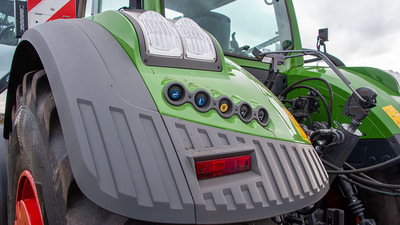
Front linkage lift capacity remains at 5.5 tonnes, while the rear has been boosted to 12.5 tonnes. A front ISObus socket is also a feature.
As before, hydraulics and transmission get their own individual reservoirs.
Apart from final drive and half-shafts, rear-end layout is pretty much the same as before. Usefully, the linkage hydraulic stabiliser option will now fit with 900mm-wide tyres.
Tyres and ballast
rear tyres
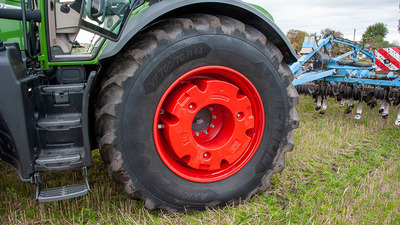
Our test machine featured a new tyre size for the 900, which is a 750/70 R44. At 2.2m tall, it is designed to offer a longer and larger footprint, and works well with the firm's VarioGrip central tyre inflation system (CTIS).
CTIS is not something you may have seen too much of up until recent years, but as tractors get more powerful and tyre technology evolves, systems like VarioGrip are really coming into their own. Particularly as soil health awareness continues to rise, the ability to adjust tyre pressures on the move comes in very handy, with the facility to save settings for road and field.
gripassist
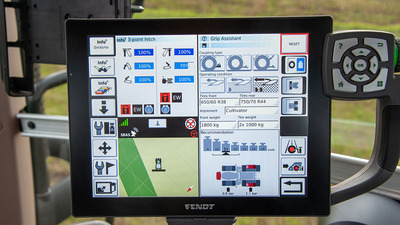
In addition to this, and enabled by the VarioDrive transmission, 900 series tractors can now be specified with the company's GripAssist. As the name suggests, based on implement, operation, working speed and conditions, GripAssist will offer up tyre pressure and ballasting advice. And by all accounts, it is pretty close to the mark when compared to the advice of tyre specialists.
However, in the real world, you do not always have time to remove or add ballast for every job. With this in mind, GripAssist can take into account the ballast you are ‘stuck with' and compensate by recommending an appropriate forward speed, as well as tyre pressure advice.
Verdict
Despite a whole raft of changes, the new Fendt 900 Vario series neatly picks up from where the old one left off and sticks with the firm's ethos of a powerful yet relatively lightweight tractor.
The stars of the show are the engine and transmission duet, which go a long way to maximising fuel efficiency while improving productivity.
As you would expect, it is a refined machine and does not feel like a 415hp tractor when driving. Between the wasp waist and pull-in front axle, it is no slouch when manoeuvring either.
And while the current controls are far from past it, the icing on top of this tractor will be when the firm's new FendtOne operating concept is introduced.
























